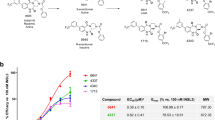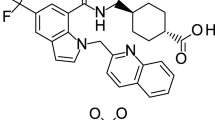Abstract
Urotensin II (U-II) is the peptide ligand for the G-protein-coupled U-II receptor (UT). U-II has been dubbed “the most potent vasoconstrictor identified to date”. However, in vivo studies with this system are hampered by the paucity of available ligands. Here, we characterise Chinese hamster ovary (CHO) cells expressing the human UT receptor in the following assays; (1) [125I]U-II binding, (2) GTPγ[35S] binding, (3) cAMP formation, and (4) intracellular Ca2+. We assess activity of 9 U-II analogues using these paradigms and examine their ability to contract isolated rat aorta. CHOhUT cells bound [125I]U-II with a B max and K d of 1,110±70 fmol/mg protein and 742 pM, respectively. hU-II stimulated GTPγ[35S] binding (pEC50 8.38), optimal at low (0.1 μM) GDP concentrations. The hU-II GTPγ[35S] response was partially PTx sensitive and there was a potent (pEC50 9.23) low efficacy (∼20% inhibition) coupling to adenylyl cyclase. In CHOhUT cells hU-II stimulates calcium release from intracellular stores (pEC50 8.80) and calcium influx in a PTx-insensitive manner. In our structure-activity relationship study most ligands acted as full agonists. However, urantide behaved as a partial agonist (pEC50 7.67/pKB 7.55) in GTPγ[35S] binding, a full agonist (pEC50 8.11) for increases in intracellular Ca2+ and a competitive antagonist in the rat aorta bioassay (pKB 8.59). Collectively, these data show promiscuity at high expression and indicate the need for careful multi-assay evaluation of novel U-II analogues. Further modification of urantide, in order to eliminate residual agonist activity and to identify novel ligands for in vivo cardiovascular studies are clearly warranted.






Similar content being viewed by others
References
Ames RS, Sarau HM, Chambers JK, Willette RN, Aiyar NV, Romanic AM, Louden CS, Foley JJ, Sauermelch CF, Coatney RW, Ao Z, Disa J, Holmes SD, Stadel JM, Martin JD, Liu WS, Glover GI, Wilson S, McNulty DE, Ellis CE, Elshourbagy NA, Shabon U, Trill JJ, Hay DW, Douglas SA et al.(1999) Human urotensin-II is a potent vasoconstrictor and agonist for the orphan receptor GPR14. Nature 401:282–286
Behm DJ, Harrison SM, Ao Z, Maniscalco K, Pickering SJ, Grau EV, Woods TN, Coatney RW, Doe CP, Willette RN, Johns DG, Douglas SA (2003) Deletion of the UT receptor gene results in the selective loss of urotensin-II contractile activity in aortae isolated from UT receptor knockout mice. Br J Pharmacol 139:464–472
Behm DJ, Doe CP, Johns DG, Maniscalco K, Stankus GP, Wibberley A, Willette RN, Douglas SA (2004) Urotensin-II: a novel systemic hypertensive factor in the cat. Naunyn Schmiedebergs Arch Pharmacol 369:274–280
Breivogel CS, Selley DE, Childers SR (1998) Cannabinoid receptor agonist efficacy for stimulating [35S]GTPgammaS binding to rat cerebellar membranes correlates with agonist-induced decreases in GDP affinity. J Biol Chem 273:16865–16873
Camarda V, Rizzi A, Calo G, Gendron G, Perron SI, Kostenis E, Zamboni P, Mascoli F, Regoli D (2002) Effects of human urotensin II in isolated vessels of various species; comparison with other vasoactive agents. Naunyn Schmiedebergs Arch Pharmacol 365:141–149
Camarda V, Song W, Marzola E, Spagnol M, Guerrini R, Salvadori S, Regoli D, Thompson JP, Rowbotham DJ, Behm DJ, Douglas SA, Calo G, Lambert DG (2004) Urantide mimics urotensin-II induced calcium release in cells expressing recombinant UT receptors. Eur J Pharmacol 498:83–86
Cheng Y, Prusoff WH (1973) Relationship between the inhibition constant (K1) and the concentration of inhibitor which causes 50 per cent inhibition (I50) of an enzymatic reaction. Biochem Pharmacol 22:3099–3108
Cooper DM, Mons N, Fagan K (1994) Ca(2+)-sensitive adenylyl cyclases. Cell Signal 6:823–840
Cooper DM, Mons N, Karpen JW (1995) Adenylyl cyclases and the interaction between calcium and cAMP signalling. Nature 374:421–424
Coy DH, Rossowski WJ, Cheng BL, Taylor JE (2002) Structural requirements at the N-terminus of urotensin II octapeptides. Peptides 23:2259–2264
Douglas SA (2003) Human urotensin-II as a novel cardiovascular target: ‘heart’ of the matter or simply a fishy ‘tail’? Curr Opin Pharmacol 3:159–167
Douglas SA, Ohlstein EH (2000) Human urotensin-II, the most potent mammalian vasoconstrictor identified to date, as a therapeutic target for the management of cardiovascular disease.Trends Cardiovasc Med 10: 229–237
Douglas SA, Dhanak D, Johns DG (2004a) From ‘gills to pills’: urotensin-II as a regulator of mammalian cardiorenal function. Trends Pharmacol Sci 25:76–85
Douglas SA, Naselsky D, Ao Z, Disa J, Herold CL, Lynch F, Aiyar NV (2004b) Identification and pharmacological characterization of native, functional human urotensin-II receptors in rhabdomyosarcoma cell lines. Br J Pharmacol 142:921–932
Douglas SA, Behm DJ, Aiyar NV, Naselsky D, Disa J, Brooks DP, Ohlstein EH, Gleason JG, Sarau HM, Foley JJ, Buckley PT, Schmidt DB, Wixted WE, Widdowson K, Riley G, Jin J, Gallagher TF, Schmidt SJ, Ridgers L, Christmann LT, Keenan RM, Knight SD, Dhanak D (2005) Nonpeptidic urotensin-II receptor antagonists I: in vitro pharmacological characterization of SB-706375. Br J Pharmacol 145:620–635
Gardiner SM, March JE, Kemp PA, Davenport AP, Bennett T (2001) Depressor and regionally-selective vasodilator effects of human and rat urotensin II in conscious rats. Br J Pharmacol 132:1625–1629
Gardiner SM, March JE, Kemp PA, Bennett T (2004) Bolus injection of human UII in conscious rats evokes a biphasic haemodynamic response. Br J Pharmacol 143:422–430
Grynkiewicz G, Poenie M, Tsien RY (1985) A new generation of Ca2+ indicators with greatly improved fluorescence properties. J Biol Chem 260:3440–3450
Guerrini R, Camarda V, Marzola E, Arduin M, Calo G, Spagnol M, Rizzi A, Salvadori S, Regoli D (2005) Structure-activity relationship study on human urotensin II. J Pept Sci 11:85–90
Hanoune J, Defer N (2001) Regulation and role of adenylyl cyclase isoforms. Annu Rev Pharmacol Toxicol 41:145–174
Itoh H, McMaster D, Lederis K (1988) Functional receptors for fish neuropeptide urotensin II in major rat arteries. Eur J Pharmacol 149:61–66
Johnson EE, McDonald J, Nicol B, Guerrini R, Lambert DG (2004) Functional coupling of the nociceptin/orphanin FQ receptor in dog brain membranes. Brain Res 1003:18–25
Kitayama M, Barnes TA, Carra G, McDonald J, Calo G, Guerrini R, Rowbotham DJ, Smith G, Lambert DG (2003) Pharmacological profile of the cyclic nociceptin/orphanin FQ analogues c[Cys(10,14)]N/OFQ(1–14)NH(2) and c[Nphe(1),Cys(10,14)]N/OFQ(1–14)NH(2). Naunyn Schmiedebergs Arch Pharmacol 368:528–537
Labarrere P, Chatenet D, Leprince J, Marionneau C, Loirand G, Tonon MC, Dubessy C, Scalbert E, Pfeiffer B, Renard P, Calas B, Pacaud P, Vaudry H (2003) Structure-activity relationships of human urotensin II and related analogues on rat aortic ring contraction. J Enzyme Inhib Med Chem 18:77–88
Leff P, Dougall IG (1993) Further concerns over Cheng-Prusoff analysis. Trends Pharmacol Sci 14:110–112
Lim M, Honisett S, Sparkes CD, Komesaroff P, Kompa A, Krum H (2004) Differential effect of urotensin II on vascular tone in normal subjects and patients with chronic heart failure. Circulation 109:1212–1214
Milligan G (1988) Techniques used in the identification and analysis of function of pertussis toxin-sensitive guanine nucleotide binding proteins. Biochem J 255:1–13
Milligan G (2003) Principles: extending the utility of [35S]GTPgammaS binding assays. Trends Pharmacol Sci 24:87–90
Parekh AB, Putney JW Jr (2005) Store-operated calcium channels. Physiol Rev 85:757–810
Patacchini R, Santicioli P, Giuliani S, Grieco P, Novellino E, Rovero P, Maggi CA (2003) Urantide: an ultrapotent urotensin II antagonist peptide in the rat aorta. Br J Pharmacol 140:1155–1158
Qi JS, Minor LK, Smith C, Hu B, Yang J, Andrade-Gordon P, Damiano B (2005) Characterization of functional urotensin II receptors in human skeletal muscle myoblasts: comparison with angiotensin II receptors. Peptides 26:683–690
Russell FD, Molenaar P (2004) Cardiovascular actions of human urotensin II-considerations for hypertension. Naunyn Schmiedebergs Arch Pharmacol 369:271–273
Sprague J, Harrison C, Rowbotham DJ, Smart D, Lambert DG (2001) Temperature-dependent activation of recombinant rat vanilloid VR1 receptors expressed in HEK293 cells by capsaicin and anandamide. Eur J Pharmacol 423:121–125
Varga EV, Rubenzik M, Grife V, Sugiyama M, Stropova D, Roeske WR, Yamamura HI (2002) Involvement of Raf-1 in chronic delta-opioid receptor agonist-mediated adenylyl cyclase superactivation. Eur J Pharmacol 451:101–102
Vergura R, Camarda V, Rizzi A, Spagnol M, Guerrini R, Calo G, Salvadori S, Regoli D (2004) Urotensin II stimulates plasma extravasation in mice via UT receptor activation. Naunyn Schmiedebergs Arch Pharmacol 370:347–352
Zhu YZ, Wang ZJ, Zhu YC, Zhang L, Oakley RM, Chung CW, Lim KW, Lee HS, Ozoux ML, Linz W, Bohm M, Kostenis E (2004) Urotensin II causes fatal circulatory collapse in anesthesized monkeys in vivo: a “vasoconstrictor” with a unique hemodynamic profile. Am J Physiol Heart Circ Physiol 286:H830–H836
Author information
Authors and Affiliations
Corresponding author
Additional information
W. S. and J. M. contributed equally to this work.
Rights and permissions
About this article
Cite this article
Song, W., McDonald, J., Camarda, V. et al. Cell and tissue responses of a range of Urotensin II analogs at cloned and native urotensin II receptors. Evidence for coupling promiscuity. Naunyn Schmied Arch Pharmacol 373, 148–157 (2006). https://doi.org/10.1007/s00210-006-0057-2
Received:
Accepted:
Published:
Issue Date:
DOI: https://doi.org/10.1007/s00210-006-0057-2




